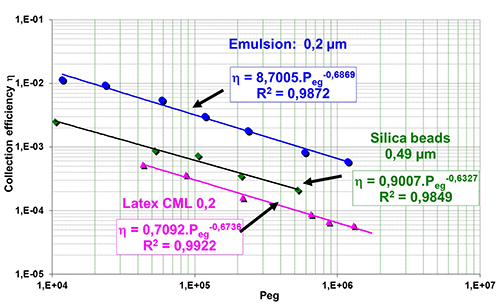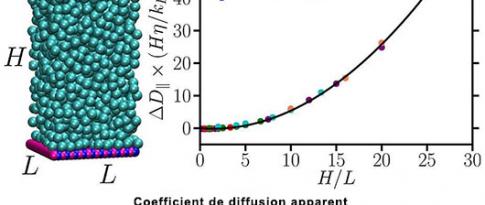The transport of colloidal particles in porous media is relevant to a number of fields, including geosciences and environmental engineering. Particle-matrix interactions can lead to deposit formation and accumulation, potentially damaging the medium and altering its permeability.
This phenomenon is particularly frequent in numerous natural and industrial systems where matter is present in a finely divided state: examples include the fields of oil production (solid particles, emulsions, asphaltene, etc.), geothermal energy and water and soil pollution remediation. During fluid production and reinjection operations, for example, fine particles (endogenous and/or exogenous) can plug pores in the well column under the effect of major physicochemical and hydrodynamic changes, significantly reducing injectivity and productivity, sometimes to the point that the well has to be decommissioned. Controlling these phenomena in porous media thus represents a major challenge for the industries concerned.
At IFPEN, the problem was originally studied for oil and gas production, but research has now been extended to include the fields of geothermal energy and geological storage of CO2. To understand and carry out experimental characterization of these deposit/plugging phenomena and their consequences on the petrophysical properties of media, dedicated tools have been developed:
- Coreflood systemsa with intermediate pressure readings enabling Darcyb scale deposit formation characterization.
- A high-pressure membrane filtration system equipped with a camera to monitor the evolution of cake thickness (particle accumulation at the entrance to the medium)c.
- Micro-modelsd enabling the direct observation of these flow phenomena at pore level, as well as the characterization of deposits and mechanisms involved at this scale.
Their use in a number of research projects has made it possible to identify and characterize different porous medium deposit regimes and kinetics, and propose physical modeling, both generic and original. This takes the form of a scale law, of the Peclet (Peg)e number power law type, with a universal exponent equal to -2/3 and a prefactor that depends on the nature of the particle, as illustrated by the figure for three types of colloids.
Click on the picture to enlarge

A pragmatic approach was then proposed for injectivity loss modeling. This is based, firstly, on the physical modeling described above concerning internal damage (deposit formation) and, secondly, on empirical correlations for external damage (external filtration cake). These models have recently been integrated into a reactive transport simulation toolf [3], one use of which is to model CO2 injection in the underground environment during sequestration operations.
This work once again illustrates IFPEN’s capacity to exploit its experimental resources, models, and multidisciplinary expertise to support progress in fields of vital importance to the ecological transition[4].
a- Fluid injection experiment in a rock core.
b- 1 Darcy = 0.97.10-12 m2.
c- Combined with measurement of pressure loss, this information makes it possible to characterize the external cake (in terms of permeability, kc, and density, ρc) and the relationship between water quality, Ω (Ω = Cparticles/ kc.ρc) and C concentration.
d- Glass chip engraved with a 2D porous network.
e- Number comparing convective forces with diffusive forces (Pe = v.Lc/D, where v represents fluid speed, Lc the system’s characteristic dimension and D the particle diffusion coefficient.
f- CooresFlow™ simulator.
Publications:
[1] D. Rousseau, L. Hadi et L. Nabzar, SPE Production & Operation, novembre 2008, 525-532.
[2] S. Buret, L. Nabzar et A. Jada, SPE Journal, 15(2), June 2010, 557-568. SPE-122060-PA. https://doi.org/10.2118/122060-PA.
[3] Petrobras-IFPEN R&D collaborative project on Reactive transport simulation – CooresFlow™ Phase 2, 2020-2021.
[4] Collaboration with Geofluid: “Problématique de l’injection en milieu poreux non consolidés. Processus d’endommagements et remédiations. Mesures sur sites (l’Albien) et essais en laboratoire” (Problem of injection in unconsolidated porous media. Damage processes and remediations. On-site (Albien) measurements and laboratory tests), Ademe project on geothermal energy, 2020-2022.
Scientific contacts: jalila.boujlel@ifpen.fr and lahcen.nabzar@ifpen.fr
You may also be interested in
In situ study of the detailed structure of a foam flowing in a real porous medium
Foam injection during oil production or ground remediation is aimed at overcoming problems of gravity segregation and viscous fingeringa created by
Improving the simulation of the transport process in nanopores using molecular dynamics
THESIS BY PAULINE SIMONNIN
Improving the simulation of the transport process in nanopores using molecular dynamics
THESIS BY PAULINE SIMONNIN






